Concentrating On the "Easy Saves"
Welcome to the Goalkeeping Newsletter. Today’s topic deals with concentrating on the “easy” saves.
Normally when we speak about making the goal smaller we are referring to cutting off the angle.
Continue readingWelcome to the Goalkeeping Newsletter. Today’s topic deals with concentrating on the “easy” saves.
Normally when we speak about making the goal smaller we are referring to cutting off the angle.
Continue readingToday's article is by Justin Cresser.
Balance training should be a fundamental part of a soccer conditioning program, but it is a component of conditioning that is frequently neglected by coaches. Developing good balance is essential for soccer players as it improves co-ordination and body awareness that is required in many game situations such as changing direction quickly or receiving passes under pressure. Balance training is also very important in the prevention of injuries. Think of the many instances where a player lands awkwardly after jumping to make a header or after a poor challenge. Having good control of the body lessens the chances of a player getting hurt.
One good thing about balance training is that you don't need to do many exercises to get a beneficial effect. Doing a few sets of just one or two exercises at the start of your conditioning or regular training session will be sufficient. Consider doing the following simple exercise at your next practice to improve your player's dynamic balance.
As I've discussed in earlier posts, I think that most coaches agree that our players don't watch the game being played at the highest level enough. Kids in countries where soccer is part of their culture grow watching professional player every week so when it comes time for them play they have a rich source of creative ways to break down defenses. They've watched Messi and Iniesta rip apart a back four with quick passing combinations and then tried the same thing with their friends at the park. Our players need to be given examples of ways to create goal scoring opportunities so they can look for those situations
Continue readingWelcome to the FineSoccer Drills Newsletter. Today’s featured activity is the first step in working on finishing with combination play.
Start with groups of 3’s spread out 30 yards from goal. Each player has a ball. A keeper is in goal.
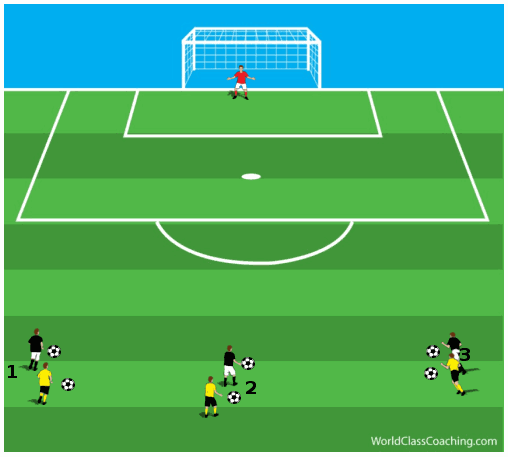
Player 1 starts by dribbling toward the top of the 18, making a move and
Welcome to the Goalkeeping Newsletter. Today’s topic deals with through balls. One of the most difficult things for a keeper to do is deal with through balls. Some of the decisions that have to be made include: Should I go outside the box and clear the ball? Should I stay inside the 18 and let
Continue readingHere is a simple activity that works on explosiveness, agility and ball skills.
Start with 4 hurdles (height can vary depending upon the player but 1-2 feet high work fine) spaced in a line 1 yard apart. The players starts behind the last hurdle and there are 2 servers 5 yards from the first hurdle each slightly off to the side. The servers each have a ball.
The player starts by jumping over the first hurdle then quickly slides to his right and receives a pass from
Continue readingWelcome to the FineSoccer Drills Newsletter. Today's featured activity works on attacking with an overlap as well as defending the overlapping run.
Start with a keeper in goal and two attackers and one defender. The attackers are around 35 yards from goal to start and the ball starts with the middle player.
The player with the ball passes to his teammate who then
Continue readingWelcome to the FineSoccer Drills Newsletter. Today's featured activity works on dribbling and taking players on.
Start with your team in a 30 x 30 grid (smaller if you don't have a full team available) with half the players with balls and the other half without.
The players with balls are dribbling at half speed and the
Continue readingWelcome to the FineSoccer Drills Newsletter. Today's featured activity works on passing with proper pace.
Start with 6 players on the perimeter of a circle with a diameter of around 20 yards. They are in groups of 2's and are opposite their partners in the group. There is one ball per group.
The players start off passing back and forth with their partner. They play
Continue readingWelcome to the FineSoccer Drills Newsletter. Today's featured activity works on forwards working together, combination play and finishing.
Start with a keeper in goal, two forwards staggered but close together and a few players in line near midfield with balls.
The first player in line plays the ball to the deep forward (who has
Continue readingBy Ricky Clarke
Patrice Evra holds the blame for Liverpool’s late winner this weekend in the FA Cup 4th round. Evra has made some poor defensive mistakes recently, this weekend cost Manchester United a place in the 5th round of the FA Cup.
Below, I’ve outlined his key movements during Liverpool’s second goal.
Evra – Out of position (Part 1)
Evra’s starting position is really poor. With minutes remaining in the game he needs to be more compact.
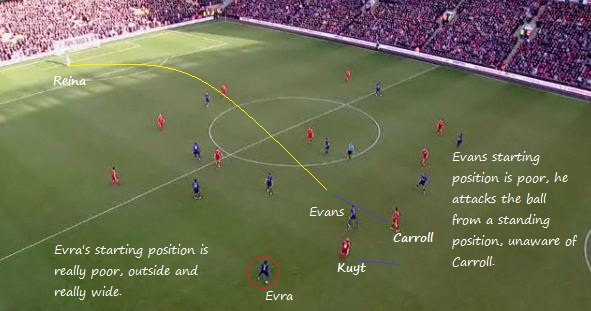
Evra – Out of position (Part 2)
Carroll wins the header and sets up Kuyt. Smalling fails to recover and Evra’s recovery is too
Continue readingWelcome to the FineSoccer Drills Newsletter. Today’s activity involves finishing in a competitive environment.
Start with a 30 x 30 grid with two full sized goals and a keeper in each goal. It’s 2 v 2 in the middle and in each attacking half there is a player on each sideline and a player on each part of the end line
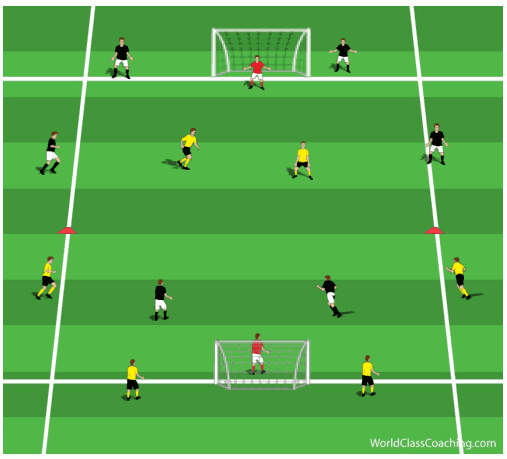
In the diagram above the black team is attacking the top goal and the yellow team is
Welcome to the Goalkeeping Newsletter. Today’s featured activity works on positioning, movement, reading the situation and shot blocking.
Start with a keeper in goal, a player with a ball at the 12 yard spot and two players on angles just outside the 18.

The keeper has to be prepared for one of three options.
Here is a fun game for young soccer players that involves a lot of running and also technical and tactical aspects. While it’s great for young players it’s interesting to do with older players as well. They will work just as hard, get just as much out of it and have a blast playing.
This game can be played with full sized goals and keepers or smaller goals without keepers. In this example the game will have keepers. The size of the field can vary but here the field is 40 x 30
Start with two teams lined up on one of the sidelines with a coach between them with balls.

The coach plays a ball to the middle of the field and the first player in each line starts by
By Ricky Clarke.
Clint Dempsey has become the first American player to score a hat-trick in the English Premier League. Dempsey produced an outstanding display of technical ability, movement and game awareness. Scoring three goals against Newcastle United in a rout this Saturday.
Below, I’ve outlined his key movements and decision-making process during his second goal.
Dempsey – Movement Pattern #1
Dempsey makes a great run across the defender, anticipating a pass from Zamora.
Continue readingWelcome to the FineSoccer Drills Newsletter. Today’s featured activity works on penetrating passes in a game environment.
In the diagram below we have a 5 v 5 game with a neutral player in white. The size of the field can vary but something in the 40 x 30 range works well.
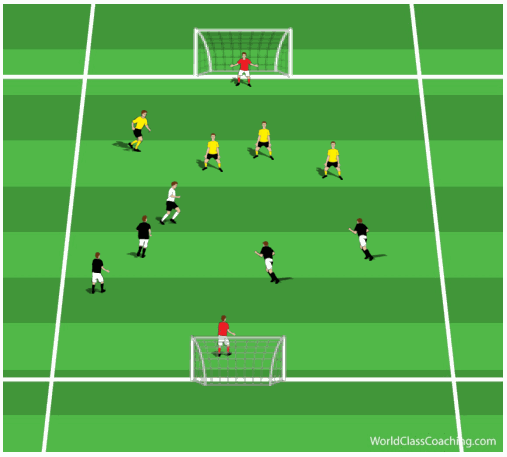
This is a typical small sided game but goals count as 3 points. A team can earn
Welcome to the Goalkeeping Newsletter. Today’s featured activity works on catching, distribution, footwork and fitness.
Start with 4 cones making up a 3 x 3 square
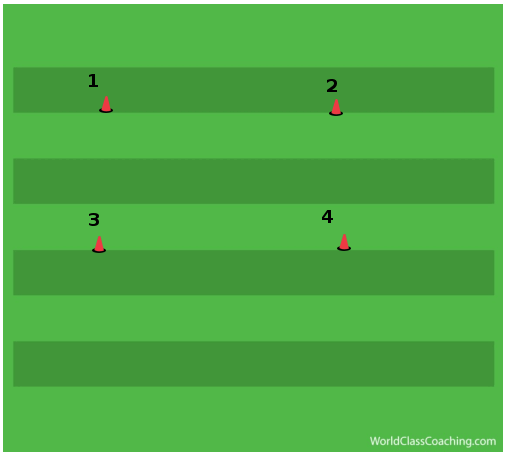
A keeper starts at cone 4 and a server starts 10 yards in front of the
Combining fitness, agility and skill work is a great way to get a lot done in a short period of time.
A simple example would start with a server with a ball and a player 10 yards away behind a cone.
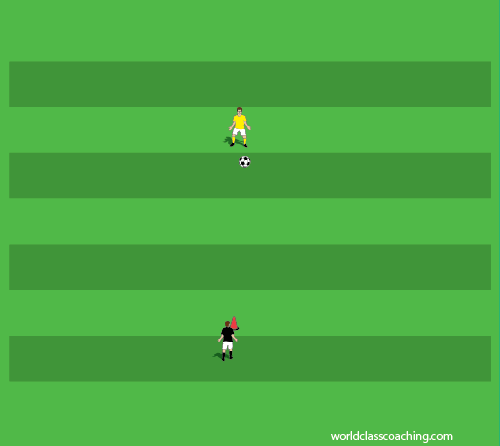
Play would start with a ball to one side of the cone, The player comes forward 1 touches the ball back to the
Today’s post is from our Soccer Conditioning Experts at Soccer F.I.T Academy and looks at whether or not having our kids specialize in soccer at an early age is beneficial or harmful.
As a fitness professional, youth club staff member, and soccer dad, I hear ALL sides of the discussions about “early specialization in youth sports across the U.S.” While this trend affects many youth sports, this dilemma as it pertains to the American soccer landscape is the most interesting in my opinion. FACT- The U.S. is behind the rest of the world in technical ability, tactical competency, and situational soccer awareness compared to our competition across the world. FACT – The ONLY way to narrow this gap is for our youth..our children… the future of U.S. Men’s & Women’s Soccer is to play…and play more. FACT – The U.S has highest rate of youth
Continue readingWelcome to the FineSoccer Drills Newsletter. Today’s featured activity works on team shape, attacking with numbers and much more.
Start with half a field with a keeper in the goal. Have a line 30 yards out across the field and also extend the sides of the 18 all the way to the midfield line. There is one attacking and one defending player in each of the wide zones and three attacking and 2 defending players in the center of the field.
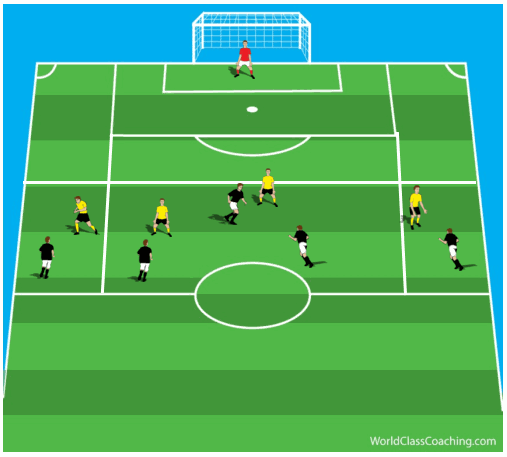
The three attackers start with a ball and they have a 3 v 2 in the center zone. If they play the
Welcome to the Goalkeeping Newsletter. Today’s featured activity works on footwork, balance and shot blocking.
The keeper starts on the near post with a server 12 yards out on a slight angle with some balls. There is a cone in the middle of the goal.
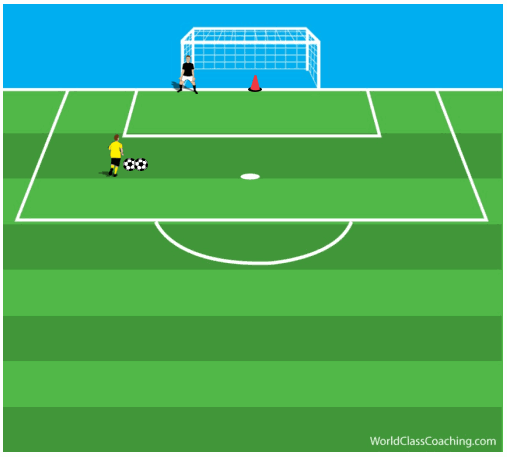
The players slides to the middle
Ideally we would like to do all fitness with a ball but the reality is there are times when pure running is helpful. Some players (and teams) simply are not capable of pushing themselves all out in soccer related activities and for those players it’s best to use activities where using fitness specific running is valuable.
In this activity you can vary the distances. I have done this with distances as short as 20 yards and as long as 120 yards. The thing I like about this activity is the faster the players run, the less distance they have to sprint. This is their incentive to really push themselves..
In the example below, we are going to use half a field for the distance. We could use a cone at each end but instead will use the goal for one end and the center circle for the other. Players start in two lines side by side
The players start by jogging around the around.
Continue readingI don't think most coaches give a lot of thought to the needs of their goalkeepers when they sit down to plan their session. They're usually just another player in the team for most of the session and then go in goal when it comes time to shoot or play a game. While it's important for all goalkeepers, especially young goalkeepers, to work with the ball at their feet they also need to train with the team in functional exercises. This establishes a link between the goalkeeper rest of the team that will translate to game day.
A book that got me thinking about this subject is, "Team Training for the Goalkeeper" by John Murphy. In this book Murphy gives examples for training your goalkeepers with the team in all phases of training. Warm-up, Functional Training, Possession, Small-Sided Games, Phase of Play exercises and 11 v 11 setting are all discussed. He also includes full sessions that integrate the goalkeeper throughout the session.
Here are a few warm-up exercises
Continue readingWelcome to the FineSoccer Drills Newsletter. Today’s featured activity is a warm up drill working on dribbling, passing, receiving and vision.
Start with a circle with a 20 yard diameter (you can use the center circle for this). Put 4 cones in the middle around 4 yards apart and surround the circle with players.
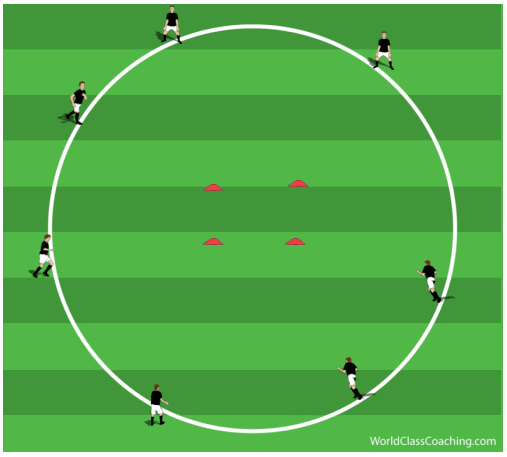
One player starts with a ball and dribbles to the middle and then